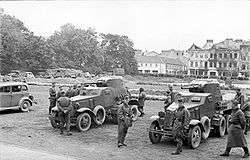BA-10
| BA-10 | |
|---|---|
|
BA-10M armored car, displayed in Finnish Tank Museum, Parola. | |
| Type | Armored car |
| Place of origin |
|
| Specifications | |
| Weight | 5.14 tonnes |
| Length | 4.65 m |
| Width | 2.00 m |
| Height | 2.20 m |
| Crew | 4 |
|
| |
| Armor | 6–15 mm |
Main armament | 45 mm gun 20-K (49 rounds) |
Secondary armament | 2× 7.62 DT machine guns (2079 rounds). |
| Engine |
GAZ-MM 50 hp (37 kW) |
| Power/weight | 10 hp/tonne |
| Suspension | wheeled |
Operational range | 300 km |
| Speed | 53 km/h |
The BA-10 (Russian: Broneavtomobil 10) was an armored car developed in the Soviet Union in 1938 and produced till 1941. It was the most produced Soviet pre-1941 heavy armored car – 3311 were built in three versions. These versions were the BA-10, the BA-10M (improved version with new radio), and the BA-10ZhD (equipped for dual railway/road use). The basic BA-10 design was developed from the BA-3 and BA-6 heavy armored cars. It had an improved GAZ-AAA chassis and improved armor (up to 15mm at front and turret). It was intended that the BA-10 would be replaced in 1941 by the BA-11 with diesel engine and more sophisticated armor design, but the outbreak of war prevented BA-11 production. The BA-10 was in Red Army service till 1945. Significant numbers of captured BA-10s were used by Finland (at least 24), Germany and other Axis powers in Europe.
Development
During the late 1930s, Soviet armoured fighting vehicle designers incorporated sloped armor into all their new designs, and redesigned some existing vehicles to take advantage of it. The BA-10 used a slightly smaller, better-sloped armor layout than that of the BA-6, thus improving protection while saving weight. The greater engine power (50 hp, compared to 40 hp on the BA-6) made the vehicle more reliable.
Like its predecessors, the BA-10 could be converted to a half-track by fitting auxiliary tracks to the rear pair of dual tandem wheels. On early BA-10s, these tracks were stowed strapped on top of the fenders. Later vehicles had an enclosed stowage box for the tracks in the same location. The tracks were often fitted when the vehicle needed to move across snow or soft ground.
In action
The BA-10 first saw action in the Spanish Civil War on 30 October 1936 when the Commune de Paris battalion, which was equipped with BA-10, engaged German Panzer I of Gruppe Thoma trying to advance on Madrid. Due to the Panzer I's poor armour the 45mm gun of the BA-10 was able to knock them out at ranges of below 500 meters/550 yards.[1]
Their next action would be against the Japanese in Manchuria at the Battle of Khalkhin Gol in 1939.

It was involved in all the Soviet Union's subsequent military operations and campaigns of 1939-1940.

During World War II the BA-10 was used against the Germans on the Eastern Front, but was rarely seen after the winter of 1941–42. Later in the war, the heavy scouting role was taken over by light tanks such as the T-60 and T-70. A few BA-10s were seen as late as 1943 on the Leningrad front.
Large numbers of captured BA-10s were used by Axis powers in Europe. In May 1945 a few BA-10s of ROA fought alongside the defenders of the Prague uprising.
References
- Notes
- ↑ Daley, Soviet and German Advisors Put Doctrine to the Test, p. 35
- Bibliography
- М. Коломиец. Броня на колёсах. История советского бронеавтомобиля 1925—1945. — Москва: Яуза, Стратегия КМ, Эксмо, 2007. — 384 с. — (Советские танки). — 6000 экз. — ISBN 978-5-699-21870-7
- А. Г. Солянкин, М. В. Павлов, И. В. Павлов, И. Г. Желтов. Отечественные бронированные машины. XX век. 1905—1941. — Москва: Экспринт, 2002. — Т. 1. — 344 с. — 2000 экз. — ISBN 5-94038-030-1
External links
- BA-10 at WWIIvehicles.com
| Wikimedia Commons has media related to BA-10. |
